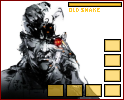|
Avenging Dentist posted:Just use the dynamic separating axis theorem: http://realtimecollisiondetection.net/files/levine_swept_sat.txt Thanks a million; this is exactly what I was looking for but none of my searches terms were turning anything up. For anyone in the same spot as me I also found this tutorial which makes it a bit easier to digest.
|
|
|
|

|
| # ? May 9, 2024 22:04 |
|
For anyone interested in free 2D art to use in their games, the Tyrian artist has a couple of cool packages, including all the Tyrian ships. http://lostgarden.com/labels/free%20game%20graphics.html CTRL+F for "Zelda" on that page. Lovely art, reminds me of Tales of Phantasia on the Super Nintendo. Of course, there's the small problem of "the rest of the game's art" but if you stick to a single village and a single forest, you should be fine 
|
|
|
|
That PlanetCute stuff is awesome, too.
|
|
|
|
Peao posted:For anyone interested in free 2D art to use in their games, the Tyrian artist has a couple of cool packages, including all the Tyrian ships. This is a wonderful resource. I'm reading through some of his other slides right now on a presentation he gave, and they are full of good information.
|
|
|
|
I found a series of really nice articles on game physics and then on networking by someone named Glenn Fiedler. They were very eye opening to me, hopefully they'll be of use to some of you as well.
|
|
|
|
not a dinosaur posted:I found a series of really nice articles on game physics and then on networking by someone named Glenn Fiedler. They were very eye opening to me, hopefully they'll be of use to some of you as well. Haha, he actually advises fixed-timestep physics and then goes on to use some stupid-rear end accumulator system instead of just using two threads. Granted, it's a couple years old, but multi-core machines have been around for a while, so not only is he using a more complicated method, he's ignoring a really easy place to make performance improvements. His writing is absolutely god-awful, too. EDIT: Also, his accumulator system will get FUBAR if physics processing takes longer than expected (e.g. on a slower computer). Avenging Dentist fucked around with this message at 23:08 on Dec 6, 2008 |
|
|
|
Avenging Dentist posted:Haha, he actually advises fixed-timestep physics and then goes on to use some stupid-rear end accumulator system instead of just using two threads. Granted, it's a couple years old, but multi-core machines have been around for a while, so not only is he using a more complicated method, he's ignoring a really easy place to make performance improvements. Agreed that threads are an obvious improvement, but what do you see going wrong with the accumulator? If the rate at which you manage to step the simulation is less than what you fixed, you just end up doing multiple updates until you catch up. What's the problem here? Am I missing something? I guess if your machine can't handle it, you could fall further and further behind and then you are hosed. Yeah, that sucks.
|
|
|
|
not a dinosaur posted:Agreed that threads are an obvious improvement, but what do you see going wrong with the accumulator? If the rate at which you manage to step the simulation is less than what you fixed, you just end up doing multiple updates until you catch up. What's the problem here? Am I missing something? Well, for one thing, I absolutely don't buy into his claim that variable-step integration methods are inherently inferior to fixed-step ones. While fixed-step integration is more predictable, integration methods like RK4 are perfectly suitable for variable-step integration, assuming the step doesn't vary too much. Actual simulations (as opposed to games) have used variable-step simulations, especially when you need varying degrees of accuracy (e.g. for a two-body collision simulation, you'd want less accuracy when the objects are far apart, and more when they are close). Games, clearly, have significantly lower requirements for accuracy than simulations proper, since in a game, "if it looks right, it is right". With games, you obviously can't predict exactly when you'll gain/lose accuracy in your timestep, but let's be honest here, we're not exactly trying to prove the existence of the Higgs boson. What the author is attempting to do is to remove the potential for variance in simulation outcomes by fixing the timestep. While this (obviously) makes for a predictable system if you have the same input each time, games generally do not behave exactly the same way each time, and so errors (such as the well-known issue of ragdolls shaking uncontrollably) will propagate from other sources. Fixing the timestep won't do much except obscure the problem in your test cases.
|
|
|
|
Avenging Dentist posted:Well, for one thing, I absolutely don't buy into his claim that variable-step integration methods are inherently inferior to fixed-step ones. While fixed-step integration is more predictable, integration methods like RK4 are perfectly suitable for variable-step integration, assuming the step doesn't vary too much. I think he is advocating fixed timesteps for two reasons. First, the articles are clearly oriented for beginners. Correct me if I'm wrong, but I would assume that while real simulations use timesteps that are variable, they certainly aren't arbitrary. Fixing the timestep is a straightforward way to overcome problems with arbitrary timesteps. Second, he's building up to presenting a (very simplified) way to synchronize physics over a network. Obviously in that case you want to minimize divergence in simulation between the client and server as much as possible. I'm still convinced his articles are at least a good place to start with a couple of intermediate game design topics. If you can suggest anything better, please do.
|
|
|
|
not a dinosaur posted:I think he is advocating fixed timesteps for two reasons. First, the articles are clearly oriented for beginners. Correct me if I'm wrong, but I would assume that while real simulations use timesteps that are variable, they certainly aren't arbitrary. Fixing the timestep is a straightforward way to overcome problems with arbitrary timesteps. Game timesteps aren't arbitrary either. A game is a pseudo-realtime environment and thus puts constraints on the maximum delta-T per timestep. It's trivial to constrain the minimum delta-T, though you'd only want to do this to avoid propagation of floating-point error with incredibly small delta-T values. not a dinosaur posted:Second, he's building up to presenting a (very simplified) way to synchronize physics over a network. Obviously in that case you want to minimize divergence in simulation between the client and server as much as possible. I only skimmed the network physics article, but none of it seems in any way dependent upon a fixed-timestep physics simulation. Fixed-timestep physics might provide a trivial improvement in network bandwidth by removing the need to occasionally send updates on the "master" location of objects, except that this ignores issues like network latency and packet loss (you can't guarantee that a packet will be received by all clients at frame N, if at all). Fundamentally, synchronizing physics objects over the network is no harder than synchronizing player objects over the network. Both need occasional updates to correct their position (and in the case of players, to supply information about their current actions), but in between updates, any relatively stable integrator should be sufficient. not a dinosaur posted:I'm still convinced his articles are at least a good place to start with a couple of intermediate game design topics. If you can suggest anything better, please do. The old adage "you get what you pay for" is appropriate here. Real-time Collision Detection by Christer Ericson and Game Physics by David H. Eberly are both highly rated, and I can say from personal experience that RTCD is a well-written book (with a few unfortunate errors).
|
|
|
|
Avenging Dentist posted:The old adage "you get what you pay for" is appropriate here. Real-time Collision Detection by Christer Ericson and Game Physics by David H. Eberly are both highly rated, and I can say from personal experience that RTCD is a well-written book (with a few unfortunate errors). Great, thanks. School library has both
|
|
|
|
Avenging Dentist posted:Fundamentally, synchronizing physics objects over the network is no harder than synchronizing player objects over the network. Both need occasional updates to correct their position (and in the case of players, to supply information about their current actions), but in between updates, any relatively stable integrator should be sufficient. There are a bunch of different models: Asynchronous (Quake 3, Unreal), delayed synchronous (Halo, Battlefield, any RTS), full authority (Red Faction, WoW), and several more recently incorporated concepts like historic lag compensation (Halo, HL2). As for fixed-timestep, the problem with variable timestep is when systems that allow penetration gently caress up when something isn't kicked out of the object by the constraints. Of course, I've only scratched the surface of it, but at least early-on, variable timestep stuff was a great way to wind up with a very unstable physics environment. OneEightHundred fucked around with this message at 06:05 on Dec 7, 2008 |
|
|
|
OneEightHundred posted:Really? Synchronizing players is probably one of the bigger challenges in a network environment, and probably the aspect with the largest number of different approaches used. ... which is why I said that synchronizing physics is no harder?? Once you have player synchronization working, physics synchronization pretty much just falls out (though you may want to put in some optimizations for physics objects). OneEightHundred posted:As for fixed-timestep, the problem with variable timestep is when systems that allow penetration gently caress up when something isn't kicked out of the object by the constraints. Of course, I've only scratched the surface of it, but at least early-on, variable timestep stuff was a great way to wind up with a very unstable physics environment. I'm not sure how fixed timesteps would resolve this issue?
|
|
|
|
Avenging Dentist posted:... which is why I said that synchronizing physics is no harder?? Once you have player synchronization working, physics synchronization pretty much just falls out (though you may want to put in some optimizations for physics objects). Fixed timesteps are more about being able to do things without synchronization than with it. If there is anything any game physics code is really, really, bad at (this includes PhysX, Havok and anything custom I've ever seen) it is achieving the exact same result in two slightly complex but identical situations when the timestep is different. It doesn't matter too much when you're talking about ragdolls, which never match up on any game, or any other simple, non-gameplay relevant effects. But it's really limiting in terms of gameplay to have to limit yourself to extremely simple scenarios involving physics because of the glitchyness of correcting on the clients, or simply due to bandwidth concerns.
|
|
|
|
krysmopompas posted:It doesn't matter too much when you're talking about ragdolls, which never match up on any game, or any other simple, non-gameplay relevant effects. But it's really limiting in terms of gameplay to have to limit yourself to extremely simple scenarios involving physics because of the glitchyness of correcting on the clients, or simply due to bandwidth concerns. How often is that actually an issue, though? I can't think of any games except Garry's Mod where there are a large number of gameplay-affecting physics objects at once. Usually it's either a handful of crates and/or barrels, which are stationary except for short bursts of activity (and even the most generic FPS only has so many crates), or it's what amounts to particle effects that can bounce off walls but don't really affect anything anyway. EDIT: How does a system like that deal with packet loss? When using a system that occasionally sends update packets to resync objects, you can just wait until the next packet comes in and update accordingly. If only one packet is ever sent out for a given object, losing that packet would mean it would never behave on the client the way the server expects it to. Avenging Dentist fucked around with this message at 09:09 on Dec 7, 2008 |
|
|
|
Avenging Dentist posted:How often is that actually an issue, though? I can't think of any games except Garry's Mod where there are a large number of gameplay-affecting physics objects at once. Usually it's either a handful of crates and/or barrels, which are stationary except for short bursts of activity (and even the most generic FPS only has so many crates), or it's what amounts to particle effects that can bounce off walls but don't really affect anything anyway. The bandwidth requirements/difficulty is why you don't see many multiplayer games with gameplay-changing physics objects. Games will usually have a reliable networking layer built on top of UDP, such that you can specify that a message is unguaranteed, guaranteed, or possibly guaranteed-ordered.
|
|
|
|
Avenging Dentist posted:How often is that actually an issue, though? I can't think of any games except Garry's Mod where there are a large number of gameplay-affecting physics objects at once. Usually it's either a handful of crates and/or barrels, which are stationary except for short bursts of activity (and even the most generic FPS only has so many crates), or it's what amounts to particle effects that can bounce off walls but don't really affect anything anyway.
|
|
|
|
cronio posted:The bandwidth requirements/difficulty is why you don't see many multiplayer games with gameplay-changing physics objects. Even with reliable networking, you would have issues, I think. Supposing you have N physics objects that get exploded, but the packets for the last K objects arrive a few frames later than expected. Do you 1) store previous physics states for the games, roll back, and recalculate physics for everything (incurring both a memory and CPU hit) 2) run the physics code for the last K objects until they're up-to-date and hope things work out 3) demand updated information from the server and hope you get lucky with packets? krysmopompas posted:It's more that you get tossing crates and barrels around because it's pretty much all we can realistically do, with the given tools. Weird multiplayer physics ideas come up all the time in brainstorming sessions but tend to get shot down pretty quickly for that reason. Well, that's part of my point. I can't think of any way to guarantee relatively accurate mirroring of physics events without providing periodic updates to correct any errors. Networking is a bitch. We should just pull a Carmen Sandiego and steal South Korea's internet.
|
|
|
|
Avenging Dentist posted:Even with reliable networking, you would have issues, I think. Supposing you have N physics objects that get exploded, but the packets for the last K objects arrive a few frames later than expected. Do you No one here is disagreeing with you. You don't see any multiplayer games with complex physics setups because it's too difficult to do right now. The last FPS I worked on (which just came out a month or so ago) does entirely peer-to-peer communication, with no authoritative server involved, so nothing physics-related is synced at all. It's simply assumed that physics is for eye-candy and nothing else.
|
|
|
|
cronio posted:No one here is disagreeing with you. You don't see any multiplayer games with complex physics setups because it's too difficult to do right now. The last FPS I worked on (which just came out a month or so ago) does entirely peer-to-peer communication, with no authoritative server involved, so nothing physics-related is synced at all. It's simply assumed that physics is for eye-candy and nothing else. Well, I'm not really arguing, I just want to make sure I'm on the same page as everyone. I'm not a professional game developer (and god willing, I'll never be), so I obviously have somewhat limited information about what real game studios do.
|
|
|
|
Avenging Dentist posted:... which is why I said that synchronizing physics is no harder?? Avenging Dentist posted:I'm not sure how fixed timesteps would resolve this issue? As far as physics synchronization goes, it is critical to do in properly in some games, especially those with VEHICLES, and there are ways to do it. BF2 does it by using delayed synchronous player movement, Unreal does it by running two simulations and using some hacky stuff to kick players out of vehicles when they get run over.
|
|
|
|
I wonder how Little Big Planet does synchronization. Almost every game object is a "gameplay-affecting physics object." Sometimes the online experience is awfully laggy, however.
|
|
|
|
Mustach posted:I wonder how Little Big Planet does synchronization. Almost every game object is a "gameplay-affecting physics object." Sometimes the online experience is awfully laggy, however. LBP is essentially a 2d game, right? I mean, the models are 3d for sure, but you don't really interact with the depth of the game. Seems like 2D physics are a whole mess more straightforward than 3D physics.
|
|
|
|
Pfhreak posted:LBP is essentially a 2d game, right? I mean, the models are 3d for sure, but you don't really interact with the depth of the game. Seems like 2D physics are a whole mess more straightforward than 3D physics. All of the objects can interact in all three dimensions. The gameplay is "2D" with three "lanes" or "layers", but objects can have variable depth and interact on any combination of the three layers.
|
|
|
|
Mustach posted:I wonder how Little Big Planet does synchronization. Almost every game object is a "gameplay-affecting physics object." Sometimes the online experience is awfully laggy, however. There's little going on other than the physics interactions, and all the real action is mostly confined the small area around the players, which reduces the number of active objects. How many players can you play with? 2? 4?
|
|
|
|
tbradshaw posted:All of the objects can interact in all three dimensions. The gameplay is "2D" with three "lanes" or "layers", but objects can have variable depth and interact on any combination of the three layers. 2^32 * 2^32 * 3 is a hell of a lot less than 2^32 * 2*32 * 2^32.
|
|
|
|
Avenging Dentist posted:2^32 * 2^32 * 3 is a hell of a lot less than 2^32 * 2*32 * 2^32. No. The gameplay is limited to the "lanes", the physics engine is not. Ala, if a log 3 "lanes" deep is rolling, and hits something only on "lane 1", it can spin off the front of the "map". Things can move forward and backwards, etc, with full physical interaction. MasterSlowPoke posted:There's little going on other than the physics interactions, and all the real action is mostly confined the small area around the players, which reduces the number of active objects. How many players can you play with? 2? 4? Yeah, 4. And you can't get too far apart or it kills the distant player. Probably the screen size * 5 or so in running world. Although, the off screen things might not be really "running", I haven't noticed either way. I know an off-screen lift still works, but perhaps only essentials are "running". tbradshaw fucked around with this message at 02:34 on Dec 8, 2008 |
|
|
|
tbradshaw posted:No. The gameplay is limited to the "lanes", the physics engine is not. Ala, if a log 3 "lanes" deep is rolling, and hits something only on "lane 1", it can spin off the front of the "map". Things can move forward and backwards, etc, with full physical interaction. Yes, but at that point, it's just for show anyway, so you don't actually need a whole lot of accuracy. I'd be willing to bet money that most of the physics is optimized for a discrete Z component and that it just makes things look like they're more complex.
|
|
|
|
Avenging Dentist posted:Yes, but at that point, it's just for show anyway, so you don't actually need a whole lot of accuracy. I'd be willing to bet money that most of the physics is optimized for a discrete Z component and that it just makes things look like they're more complex. I guess it just depends on what you consider "physics" and what you consider "rendering". It seems like a pretty flexible boundary lots of the time. I would also wager that most interactions are optimized for limited Z. The depth (ala, thoroughness rather than coordinates) of simulation is still quite involved. Enough that it provides an interesting academic exercise to consider a game that requires much physics synchronization. Especially in light of recent traffic in the thread. edit: Here's a YouTube video that shows Little Big Planet displaying exactly 2D behavior, http://www.youtube.com/watch?v=3e84YLG8NRU.
|
|
|
|
tbradshaw posted:edit: Here's a YouTube video that shows Little Big Planet displaying exactly 2D behavior, http://www.youtube.com/watch?v=3e84YLG8NRU.
|
|
|
|
OneEightHundred posted:If everything is exactly on the same Z coordinate, and symmetrical along the XY plane (which spheres are), then it's going to wind up looking 2D because there is nothing pushing anything along the Z axis. Fair, an alternative: http://www.youtube.com/watch?v=Z8HkbqEGSic&feature=related
|
|
|
|
tbradshaw posted:Fair, an alternative: http://www.youtube.com/watch?v=Z8HkbqEGSic&feature=related To be honest, this behaves as if there was no 3rd dimension.
|
|
|
|
Pfhreak posted:To be honest, this behaves as if there was no 3rd dimension. Yes, agreed. As Avenging Dentist supposed, other than a few discrete z-axis values, the 3rd dimension appears to only be used for rendering.
|
|
|
|
tbradshaw posted:Yes, agreed. As Avenging Dentist supposed, other than a few discrete z-axis values, the 3rd dimension appears to only be used for rendering. Avenging Dentist! I have a stupid openGL question: How the hell do you do texture mapping? I know this seems like something that should be a no-brainer, just go google for it right? But every tutorial or explanation seems to do it entirely differently. I have a book that uses glBitmap, an example that uses some strange bind call and also looks at least 10 years old and my professor does it some terrible way where he creates the bitmap every frame. So I'm betting that there is a generally accepted, clean and fast way do load textures and render them onto quads in openGL. code:
|
|
|
|
Contero posted:
Is it an RGB bitmap or an RBG bitmap? You need to generate a texture using glGenTextures and load the image data to it with glTexImage2D. If you're only rendering the one object, you could move the glEnable and glBindTexture calls out of the loop. glTexCoord lays out texture coordinates on the quad. edit: You're also going to want a corresponding glDeleteTextures somewhere. a slime fucked around with this message at 06:05 on Dec 9, 2008 |
|
|
|
not a dinosaur posted:Is it an RGB bitmap or an RBG bitmap? Yes I meant RGB. This is awesome. See, your code doesn't look insane and I can actually see what calls are relevant to the texture mapping. I'll give this a try. Thanks.
|
|
|
|
Contero posted:Yes I meant RGB. I left something out- before doing glTexImage2D, you need to call glPixelStorei code:I think it's a few pages back now, but we do have an OpenGL thread here in CoC. People there will be much better at answering your questions.
|
|
|
|
Avenging Dentist posted:Well, for one thing, I absolutely don't buy into his claim that variable-step integration methods are inherently inferior to fixed-step ones. While fixed-step integration is more predictable, integration methods like RK4 are perfectly suitable for variable-step integration, assuming the step doesn't vary too much. A good secondary benefit to fixing a timestep is that all of your physics code gets faster, because you've eliminated a shed load of multiplies.
|
|
|
|
not a dinosaur posted:I left something out- before doing glTexImage2D, you need to call glPixelStorei You don't need glPixelStorei. And technically, shouldn't he be using PBO's :P
|
|
|
|

|
| # ? May 9, 2024 22:04 |
|
I've got a program that has a structure similar to this (in C#):code:code:
|
|
|













